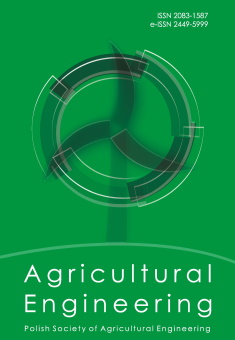Recent developments in the Evaluation of the Performance of Vineyard Sprayers
DOI:
https://doi.org/10.2478/agriceng-2024-0023Keywords:
Spray deposition, 3D crops, Spray driftAbstract
Vines are perennial crops that appear sensitive to various diseases and insects with a subsequent number of spray applications per year. In general, biological efficacy is strongly linked to the spray quantity and quality, assuming that non-intercepted droplets may lead to ground or atmospheric losses. This paper corresponds to a synthetic review focusing on need for generic methodology to assess vineyard sprayer deposition performance. Indeed, the deposition of droplets in a 3D canopy is a complex phenomenon that encompasses a wide range of variability that limits the capability for evaluating and for comparing field tests. Different levels of crop variability were identified among the cultivar, the development stage and the training strategy leading to a highly variable leaf area index over time. Other sources of variability depend on the sprayer technology where the air assistance and droplet emitters play a key role. Assuming the difficulties in the comparison of sprayers directly through field tests, the rationale for a fair and replicable comparison of sprayer deposition performance was developed by the joint unit UMT Ecotech between INRAE and associated technical institutes for vines (IFV) and fruit crops (CTIFL). An original methodology to assess sprayer deposition capability was developed based on an artificial vineyard whereas the potential spray drift of the complete sprayer is evaluated using an artificial wind generator. These test benches are now used in a purpose of official classification by French authorities.
References
Balsari, P., Marucco, P., Tamagnone, M. (2005). A system to assess the mass balance of spray applied to tree crops. Transactions of the ASABE. Vol. 48(5), 1689-1694.
Chahine, A. (2011). Modelling of aerial dispersion of pesticides from local to regional scales, influence of infrastructures and quantification of levels of exposure. PhD Thesis University of Montpellier (in French) 184p. Link available on Dec 9th 2024: https://theses.fr/2011NSAM0037?domaine=theses
Cheraiet, A., Naud, O., Carra, M., et al. (2022). Evaluation of the distribution of spray deposits within a vine canopy from measurements on artificial targets and real leaves. Oeno One. Vol. 56(4).
Cheraiet, A., Codis, S., Lienard, et al. (2024). EvaSprayViti: a flexible test bench for comparative assessment of the 3D deposition efficiency of vineyard sprayers at multiple growth stages Biosystems Engineering. Vol. 241(3), 1-14. https://dx.doi.org/10.1016/j.biosystemseng.2024.03.008.
Djouhri, M. 2022. Modelling of spray distribution and spray drift of pesticides during a spray application and their contribution to bystander exposure: case of viticulture. PhD thesis University of Montpellier (in French), 189p. Link available on Dec 9th, 2024: https://ged.scdi-montpellier.fr/florabium45/jsp/nnt.jsp?nnt=2022UMONG073.
Djouhri, M., Loubet, B., Bedos, C., et al. (2023). ADDI-Spraydrift: A comprehensive model of pesticide spray drift with an assessment in vineyards, Biosystems Engineering. Vol. 231, 57-77. https://doi.org/10.1016/j.biosystemseng.2023.05.008.
Fritz, B.K., Hoffmann, W.C., Martin, D.E., Butts, B.K. (2018). Mass Balance and Swath Displacement Evaluations from Agricultural Application Field Trials. In Pesticide Formulation and Delivery Systems: 38th Symposium on Innovative Application, Formulation and Adjuvant Technologies. New Orleans, LA. ASTM Int Comm E35 Pesticides Antimicrobials & Alternat Control Agents, volume 1610, 11-23. https://doi.org/10.1520/STP161020170204.
Gil, Y., Sinfort, C., Brunet, Y. (2007). Atmospheric loss of pesticides above an artificial vineyard during air-assisted spraying. Atmospheric Environment. Volume 41, 2945-2957. https://doi.org/10.1016/j.atmosenv.2006.12.019.
Grella, M., Marucco, P., Oggero, G., Manzone, M., (2022). Environmental Evaluation of Vineyard Airblast Sprayers Through a Comprehensive Spray Mass-Balance Approach. In: Biocca, M., Cavallo, E., Cecchini, M., Failla, S., Romano, E. (eds) Safety, Health and Welfare in Agriculture and Agro-food Systems. SHWA 2020. Lecture Notes in Civil Engineering, 252. Springer, Cham. https://doi.org/10.1007/978-3-030-98092-4_39.
Holterman, H. J., Van de Zande, J. C., Huijsmans, J. F. M., Wenneker, M. (2017). An empirical model based on phenological growth stage for predicting pesticide spray drift in pome fruit orchards. Biosystems Engineering. Vol. 154, 46–61. https://doi.org/10.1016/j.biosystemseng.2016.08.016
Jensen, P.K. and Olesen M.H. (2014). Spray mass balance in pesticide application: A review. Crop Protection, volume 61, 23-31. https://doi.org/10.1016/j.cropro.2014.03.006
Pergher, G. & Petris, R. (2007). Pesticide Dose Adjustment in Vineyard Spraying and Potential for Dose Reduction. Agricultural Engineering International: the CIGR Ejournal. X.
Salyani, M., Farooq, M., Sweeb, RD. (2007). Spray deposition and mass balance in citrus orchard applications. Transactions of the ASABE, 50(6), 1963-1969.
Teske, M. E., Thistle, H. M., & Ice, G. G. (2003). Technical Advances In Modeling Aerially Applied Sprays. Transactions of the ASABE, 46(4), 985–996. https://doi.org/10.13031/2013.13955
Zadoks, J.C. (1974). A decimal code for the growth stages of cereals, Weed Research, volume 14, 415–421.
Downloads
Published
Issue
Section
License
Copyright (c) 2025 Jean-Paul Douzals et al., published by Sciendo

This work is licensed under a Creative Commons Attribution 4.0 International License.

